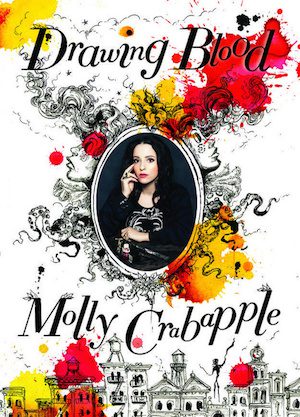Here’s a weird confession: I actually have a list on my computer of enviably good similes invented by other writers, which I revisit when I need to be buoyed by the possibility of bottomless creativity. I don’t add to it often, but when I started to read Omar Musa’s novel Here Come the Dogs and he compared the heads of a crowd to “bobbling balloons,/waiting to be unfastened,” I figured I better keep that Word doc open. Here Come the Dogs is a wallop of a novel about three young men living perpetually, by virtue of their ethnic identities, on the fringes of Australian society; reading it transported me to an Australia I had never considered, and taught me about the teeming race relations there in a way that a textbook or newspaper article never could. Speaking of transportation, Musa, a slam poet, rapper, and novelist, was gracious enough to let us into his reading life while on a whirlwind US tour. Below, he tells us about how airplane delays can lead to productive reading sessions and how easy it is to get sucked into Internet wormholes about geodesic domes.
***
Wednesday, 6th of April
Today I finished reading a book I have been dipping in and out of lately—Drawing Blood by Molly Crabapple. I met Molly recently at the Jaipur Literature Festival in India, and it’s hard not to be swept up by her brilliant, nervous energy and hunger to find out about the world. Drawing Blood is a memoir fueled by this energy and accented with her own drawings (she is an accomplished artist whose work is in MoMa’s permanent collection). It recounts her life as an aspiring artist, Occupy Wall Street protestor, traveler, Suicide Girl, and burlesque dancer, amongst other things. There is a real sharpness of thought in these pages, as well as a tender and tenacious humanism and startling one-liners that leap off the page. This book made me want to write a memoir, but also made me realize I probably don’t have the requisite ballsiness to pull the trigger, name names, and be brutally honest about the intimate and messy parts of my life that would make good reading.
Thursday, 7th of April
Today I was in San Francisco waiting for a delayed plane, so I read a bunch of articles, including one by Shaad D’Souza on Australian website Junkee about Kendrick Lamar and the possible “appropriation and erasure” of his “dynamic portrait of black identity” by his white fans. Another article I read was on Polygraph by Hanah Anderson and Matt Daniels, an in-depth study of gender imbalance in the Hollywood film industry. Very sobering, but not surprising. Alongside graphs tabulating their analysis, the writers broke down 2,000 screenplays by gender and age, and found data that backs up anecdotal evidence that Hollywood movies are dominated by white men.
The most interesting article I read was from the New Yorker in 2014 named “I Don’t Want to Be Right” by Maria Konnikova. I found it equal parts fascinating and depressing. Essentially it is about the difficulties involved in trying to correct misperceptions on a broad scale, especially focusing on the issue of vaccination and the widespread, false perception that it is connected to autism. Brendan Nyhan, a professor of political science at Dartmouth, attempted to combat this misperception by distributing leaflets documenting various things: the absence of a proven link between MMR vaccines and autism, the dangers of these diseases, photographs of children who had suffered those diseases, and dramatic stories about a child who had nearly died of measles. None of these approaches worked; in fact, in certain cases, the evidence provided merely made the parents more suspicious of vaccines. Basically, people believe what they want to believe. This evidence made me also question myself—how many of my leftist, so-called “progressive” values are simply received knowledge, ideas based on mere feeling, as opposed to evidence? And would I ever be willing to change if confronted by contrary evidence? This last question links with another point the article makes—that a person’s ability to receive accurate information becomes sharper when one feels more positive about oneself. Thus, Nyhan found that if people practiced self-affirmation exercises before learning about highly politicized topics such as the Iraq War or global warming, they would be more likely to take in evidence-based information. All of this made me slightly depressed, especially thinking about how a climate of fear is nurtured by politicians and leads to misinformation running rampant.
Friday, 8th of April
Today I did an interview on a big morning radio show in Toronto. I was asked about Australian race relations and spoke about how my father had arrived in Australia from Malaysia in 1980, “only five years” after the notorious White Australia Policy had come to an end. This was a policy put in place in 1901 so that only people from English-speaking countries could to migrate to Australia and was instituted in particular to curb Asian immigration, though it also extended to people from Africa, Pacific, South European and Eastern European countries. It is a policy that casts a long shadow over Australian history and the point I was trying to make is that it was not all that long ago and we are still dealing with the fallout today.
After making the bold pronouncement that the policy officially ended in 1975, I had a look at the Wikipedia page about the White Australia Policy to make sure I had got the dates right. I hadn’t. I found out that it was actually 1973 that the policy officially ended, but large parts of it had been dismantled from 1949 to 1966, with the watershed moment coming when Holt Liberal Government introduced the Immigration Act 1966, “which increased access to non-European migrants.” What did happen in 1975, however (and I think this is where I got confused), was the 1975 Racial Discrimination Act, which “made the use of racial criteria for any official purpose illegal.” What did become clear to me, from reading the article, was how incremental change was in this area, how often a monolithic policy (or set of prejudices) does not die at one mighty stroke of the pen, but after a thousand little cuts. Dark parts of our history echo and do not, or will not, fade as quickly as we would like.
Saturday, 9th of April
Today I read various articles on the Internet about geodesic domes. As someone who dropped out of math in the tenth grade, I find this is a strange thing to do, because anything that verges on the mathematical tends to make my eyes glaze over. I probably comprehended about 15% of what I read. As far as I can tell, a geodesic dome is a dome made of short struts following geodesic lines (the shortest possible line between two points on a sphere) to create a structure composed of triangles and polygons. Man, I’m getting tired even attempt to describe it.
So, why am I am trying to write a poem about these mystical domes? Well, I was inspired by a conversation with an eccentric, skateboarding physicist friend of mine who is studying at Harvard University. I visited him recently and we had a coffee in the Buckminster Fuller Cafe on campus, and he told me about Bucky Fuller and how he had been an advocate for the use of geodesic domes in the creation of affordable and environmentally friendly housing. He also told me that the original, classic soccer ball was based on geodesic principles, and that image reminded me of a bag of soccer balls my best friend stole from school. It got me thinking about how obsessed we were with soccer, especially around the time of the 1998 World Cup. My friend went on to tell me that the structure of a virus also has the properties of a geodesic dome and that it relates somehow to pi. Soccer, housing and viruses. There has to be a poem in there, but I’m trying to figure out how to link them all.
I also began to read Flight by Sherman Alexie. I’ve never read any of his fiction before, only his brilliant poetry (“How to Write the Great American Indian Novel” is a classic). So far, it is about a reckless, angry, witty, pimply young guy called Zits, who goes through a revolving door of foster homes and wants to connect to his Native American heritage. It is full of acidic rage, humor, and profanity—I can tell already that this will be my kind of book.







